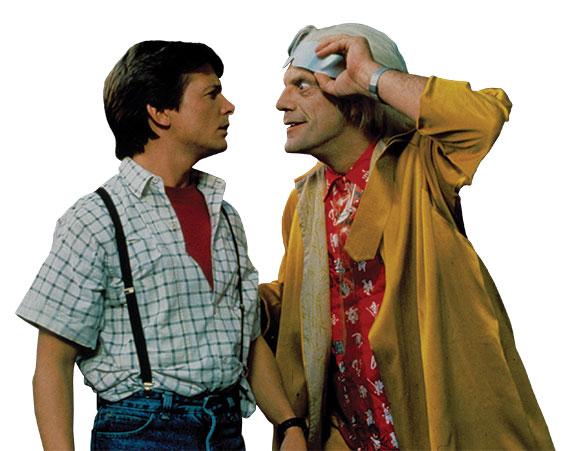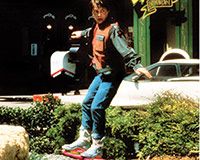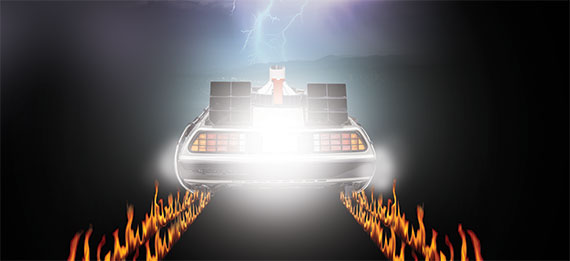21 October 2015 – to many, just another normal Wednesday. To those in the know, it was so much more. This week marked the date to which Marty McFly and Doc Brown travelled in 1980s film Back to the Future Part II. And what better way to celebrate this momentous pop culture occasion than to look ahead another 30 years. Jess Harrold clambers into his DeLorean and sets the clock to 2045…
 21 October, 2015. A milestone for any child of the 1980s, a date forever etched in movie history. The day the future – definitively if fleetingly – becomes the present. And now, distressingly, the past.
21 October, 2015. A milestone for any child of the 1980s, a date forever etched in movie history. The day the future – definitively if fleetingly – becomes the present. And now, distressingly, the past.
For this celebrated square on the calendar – once so impossibly far off, now crossed with an X – is the date that Marty McFly lands in Back to the Future Part II. This “Future Day” has sparked a year-long appraisal of how the real-life 2015 stands up to its cinematic counterpart.
And in many ways that count it falls short. Sure, we have smartphones and tablets that make Biff Tannen’s almanac of historic sports results look rather quaint. But let’s cut to the chase – our skateboarders don’t hover.
What else? Well, okay, 3D may indeed be all the rage – we will give them that. But while we have enjoyed, and then endured, Jaws 1, 2, 3 and 4 over the past 30 years, we should perhaps be relieved that we haven’t been forced to sit through sequel number 19 – “This time it’s really, really personal” – as depicted in the film. And, though it is a staple of future fiction from The Jetsons to Doc Brown’s tripped-out DeLorean, cars still haven’t taken to the skies. Perhaps worst of all, despite excited news stories all year, Nike is yet (at time of writing) to make our lives better with the self-lacing trainer.
But it is too easy to dwell on how life has disappointed the wide-eyed young moviegoers we once were. Better, surely, to use Future Day to look forward to all the wonders yet to come? Estates Gazette asked a number of forward-thinkers to imagine themselves the directors of Back to the Future IV, a hypothetical sequel relocated to these shores in which Marty journeys a further 30 years forward (although Back to the Future II came out in 1989, the action begins right where the original left off, in October 1985). With an unlimited imaginary budget for special effects, what would be their vision of Britain in 2045?
Self-driving forward
As Doc Brown puts it at the end of the first Back to the Future: “Roads? Where we’re going, we don’t need roads.” Such a prediction for Britain’s transport system would be ambitious, but, says Jon Neale, head of UK research at JLL, where we’re going we probably don’t need drivers. Indeed, in his idealised version of the future, the entire way people look at cars could be transformed 30 years down the line.
“The Utopian idea is that all cars are driverless,” he says. “That could reduce congestion. The whole way cars are used could be more efficient, they could be closer together. That would drastically change the way our cities operate, including the amount of surface area used for parking.”
His vision of a fleet of autonomous vehicles for everyday use, moving around constantly and ordered up like taxis, relies on people “giving up the idea of owning cars” and seeing them instead as a service to be used and shared. It also calls for a radical rethink of what constitutes a vehicle: “We tend to think of them as looking like a normal car but without a driver. They could be special pods, which would be a much more efficient way of getting people around.”
Neale believes that by 2045, autonomous vehicles will start to challenge how we build our cities, and perhaps reverse the trend of urbanisation and revive the suburbs as it becomes easier to move around. The homes we build will also gradually evolve. “There is a deeply nostalgic and backwards-looking element to residential development,” he says. “People like old houses and new houses to look like old houses. It’s a bit ridiculous. But the increasing importance of sustainability, and desire for more spacious living, could lead the generation coming through now to desire modern architecture that is less interested in the tradition of a house looking a certain way and having a garden.”
More building is vital, he stresses, and it has to start now. “If it doesn’t happen over the next five or ten years, the UK will not be a competitive place to do business in 2045,” he says.
Joined-up thinking
Martha Grekos, partner and London head of planning and infrastructure at Irwin Mitchell, has her own prediction of an “evolution of mobility” in the UK, led by improved connectivity via the railways. “There will be more high-speed trains, with HS2, HS3, HS4 coming through,” she says. “There will be driverless trains, which we can already see on the London Underground. It’s all about making them safer, making them quicker and putting more on the rails.” Or, rather, not on the rails, but hovering, she quickly corrects herself. High-speed rail connections might even extend under the sea to France, Ireland or even Norway, but – in order for all this to happen – she believes heavy investment in infrastructure will be needed from China through joint ventures with the UK.
She foresees not one but two new airports – or expansions – by 2045, with the accompanying rise of the “global airport city” or “aerotropolis” as businesses are drawn towards them. Airports will be at the centre of this emerging “new urban form”, with transport corridors emanating from them. This, she says, will emerge from more strategic infrastructure and urban planning and a lot more longer-term thinking on the part of politicians. “We need to integrate housing and transport infrastructure and energy far, far better,” she says. “Hopefully political boundaries will vanish and governments will be more willing to think about the longer term.”
Rise of the robots
Alex Low, head of the UK legal sector at JLL, predicts that artificial intelligence is going to transform the commercial landscape, with robots doing most of the “heavy-lifting” across a wide range of professional spheres, including legal, financial and real estate. “It’s going to go only one way,” he says. “The rate at which technology is developing is scary. But it’s fascinating.”
While having a robot personal assistant – akin to the Synths in Channel 4’s recent drama Humans – might be a possibility nearer 2045, “robots” in terms of software replacing job functions will change the delivery of professional advice much sooner, with increasingly complex real estate transactions being handled by AI.
Low says that our shopping choices are already being “guided by robots” on online sites such as Amazon that recommend additional items based on purchases. And, citing a more recent sci-fi film, he says that will move on to the high street by 2045. “If you look at Minority Report, I don’t think that’s far from being true. You walk down a shopping mall, and based on the data, only you will see the advert because that’s what you want to see. That could change the dynamic of retail real estate.”
Technology is now driving the “war on talent” for tomorrow’s professionals, and as AI begins to replace entire functions in our workplace, these factors will change the employee make-up of our companies. Surveyors may be “technology people who know something about real estate”, rather than the other way round. These factors will change how companies require and use office space. “The perception of the office is already starting to be challenged,” he says. “By the time my five-month old daughter enters the workplace, I think it is going to look very, very different.”
Neale adds that although employees will indeed continue to be increasingly tech-savvy, it will become increasingly important to secure “down-time” as instant communications become ever more prevalent in our lives. He adds: “We’ll start seeing offices built with areas that don’t have any technology in them.”
Hoverboards?
But what of the iconic visual representation of Marty McFly’s future? The closest we have come so far are the two-wheeled contraptions variously known as swegways, balance boards, self-balancing scooters or even – quite wrongly – hoverboards. They have in the past year become a more regular sight on our streets, including with city commuters.
 While the Metropolitan Police Service may have tweeted last week that swegways are technically vehicles and can be ridden legally only on private land, could this hurdle be overcome, transforming the way we move around on foot over the next three decades? Will we all be hovering to work in 2045? No, says Neale, who believes that such items will remain of “niche” interest, in contrast to cycling or his vision of pod-like automated transport.
While the Metropolitan Police Service may have tweeted last week that swegways are technically vehicles and can be ridden legally only on private land, could this hurdle be overcome, transforming the way we move around on foot over the next three decades? Will we all be hovering to work in 2045? No, says Neale, who believes that such items will remain of “niche” interest, in contrast to cycling or his vision of pod-like automated transport.
He is sceptical about sci-fi innovations such as hoverboards and flying cars, saying: “If you look at old films about the future, there’s lots of whizzy technology like hoverboards or jetpacks. No-one is ever using Twitter or making phonecalls. They’re the hard things to predict that change people’s lives but no one saw coming.”
Indeed, the best prediction for Britain in 2045 is that it will be transformed in some way that no amount of crystal balls could foresee. And if we could hop in a DeLorean and get an early glimpse of it today, there would only be one reaction: “Great Scott!”












